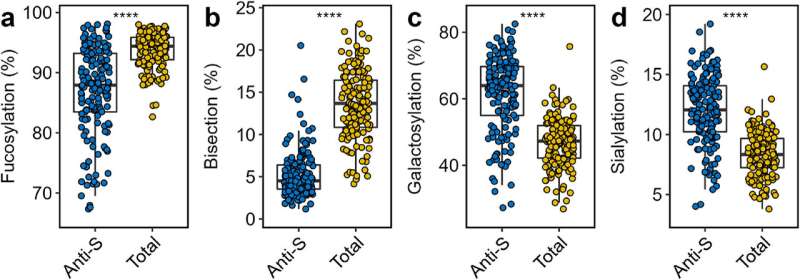Discovery of sugar-coated antibodies that predict COVID-19 disease progression

At the start of the COVID-19 pandemic, researchers from 15 departments at Leiden University Medical Center (LUMC) realized they could do more for patients if they joined forces. This is how the BEAT-COVID group has been able to rapidly gain knowledge about COVID-19, the role of the immune system and—most recently—the predictability of the course of the disease.
"Our antibodies—crucial in the fight against the SARS-CoV-2 virus—are coated with sugars. Depending on how the antibodies are coated, the sugars can change the way the antibodies behave. Based on our study, which included 159 hospitalized people (who were mildly to severely ill and who had follow-up checks after being discharged from hospital), we discovered that specific coating patterns can be observed during the early stages of infection, and that these reflect how the disease will progress," says Tamas Pongracz, a Ph.D. candidate at the LUMC's Center for Proteomics and Metabolomics (CPM). The BEAT-COVID research group's findings have been published in eBioMedicine.
In the clinic
"This is great news from a clinical perspective," says Anna Roukens, an internist-infectiologist at the LUMC's Department of Infectious Diseases. According to Roukens, there are big differences between patients who are admitted to a general ward and those who are admitted to an intensive care unit (ICU): "We therefore need to work out who needs to stay in hospital and who can be safely discharged to recover at home." Throughout the pandemic, however, determining who is at greater risk of deteriorating proved to be a major challenge. "We have seen countless times how young people who initially seem fit suddenly end up in the ICU. But now we know that certain sugars and coating patterns work as a 'marker' that can help us predict COVID-19 severity and make safer decisions about hospitalization."
"Despite our new insights into what these antibodies look like in hospitalized patients with varying disease severity, we still aren't sure what they actually do during the course of COVID-19. The study points to a link between sugar-coating patterns and inflammation, but how they contribute to disease mechanisms still needs to be studied," Pongracz notes. To address this, the researcher's next step is to investigate antibody function at the Wistar Institute in Philadelphia. "Once we've figured that out, we'll be able to look at changing COVID-19 severity in patients through therapeutic interventions," Roukens concludes.
More information: Tamas Pongracz et al, Immunoglobulin G1 Fc glycosylation as an early hallmark of severe COVID-19, eBioMedicine (2022). DOI: 10.1016/j.ebiom.2022.103957


















